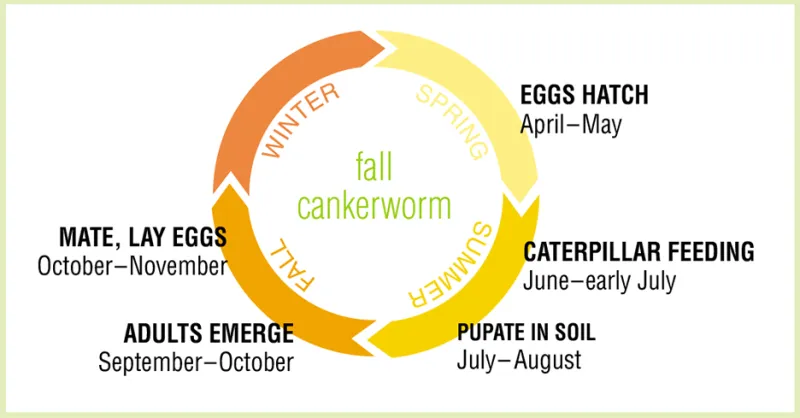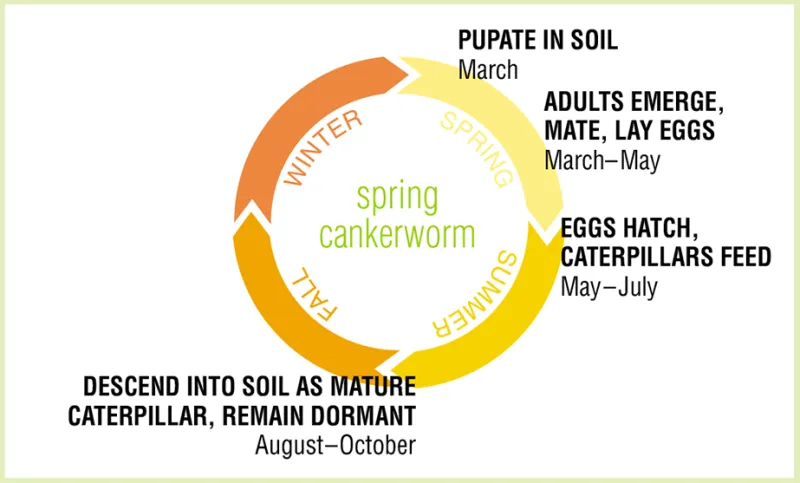■ Monitoring
Early detection of cankerworms and defoliation is important. Monitor the upper tree branches for young caterpillars and
early defoliation using binoculars during the spring from early
to late May.
Early larval feeding injury often is overlooked until large holes are present in leaves and caterpillars are mature. Insecticide treatments usually are not warranted this late because extensive defoliation already has occurred and mature caterpillars will be dropping to pupate in the soil.
■ Trunk Banding
Tree banding is not an effective control of cankerworms, although it can be used for early detection. For early cankerworm detection, place a 3- to 4-inch band of a sticky adhesive compound completely around the trunk about 5 feet above the ground (Figure 15). Because female moths are wingless and must crawl up the trunk of their host tree to lay eggs, this band traps females and prevents them from
depositing eggs on the upper trunk and branches.
Tree banding should be done during early to mid-September to trap fall cankerworms and again in mid-March to trap spring cankerworm females. The canopies of treated trees should be isolated from the canopies of neighboring trees. If the canopies of several trees intermingle, the trunks of all of the trees must
be banded.
When banding is used as an early detection technique in shelterbelts, the adhesive should be applied as soon as the snow melts. The bands should be placed selectively on three or four trees along the length of the shelterbelt and monitored weekly for the presence of trapped moths. If large numbers are present, serious defoliation is likely to occur and management may be warranted when cankerworm larvae begin feeding.
Adhesive compounds are available as a paste and also as a pressurized aerosol spray. Because the paste can be applied easily with a putty knife, it is often the best formulation to use
for the first application of a new band.
Old bands may be rejuvenated easily by spraying with the aerosol formulation. Adhesive compounds are generally nontoxic and present no potential hazards to the applicator
or environment.
■ Biological Control
Several species of parasitic wasps are known to attack eggs or caterpillars of fall and spring cankerworms (Figure 16). However, the parasitism rate is typically too low (about 15% to 20%) for effective management. A nuclear polyhedrosis virus also can infect and kill caterpillars (Figure 17), especially during outbreak years and moist conditions.
■ Chemical Control
Insecticidal control measures are most effective if implemented when the caterpillars are young (about ½ inch long) and feeding defoliation is low. Spray timing is critical and, if done at the correct time, only a single application will be needed.
Insecticides can be applied by ground-based equipment or by aerial equipment and should be directed at the trunk, branches and newly expanding leaves. Aerial application is fast and convenient and most often is used to apply insecticides in shelterbelts.
Ground-based equipment has been shown to be effective and may give better vertical coverage of foliage in the tree canopy. Good coverage of the infested trees is critical for acceptable control.
While timely insecticide treatments directed at the early larval stage of cankerworm provides effective control, many trees in residential areas are too large to treat thoroughly with spray equipment available to the average homeowner. Also, the homeowner often is unaware a cankerworm infestation exists until after extensive damage already has occurred to the tree. Insecticides listed for management of cankerworms includes biopesticides and conventional insecticides.
Biorational pesticides (Table 1) are natural pesticides from natural materials, such as minerals, bacteria, plants or animals or insect growth regulators.
Bacillus thuringiensis var. kurstaki (Btk) is a selective bacterial pathogen that kills the caterpillars of cankerworms as well as caterpillars of other moths and butterflies. These bacteria do not have a detrimental effect on beneficial insects, wildlife or humans.
Bacillus thuringiensis var. kurstaki is highly recommended for management of cankerworms where possible. For optimal control, apply Btk when caterpillars are less than ½ inch long, about 10 days after egg hatch.
Synthetic insecticides (Table 2) are recommended when caterpillars are greater than ½ inch long and extensive defoliation already has occurred.
“Always read, understand and follow the pesticide label. The label is the law.”
Table 1. Biorational pesticide products for cankerworm control.
| Active Ingredient | Commercial Trade Name |
| azadirachtin | Azatin XL, Bioneem |
| Bacillus thuringiensis var. kurstaki | DiPel, Javelin, Lepinox |
| diflubenzuron | Dimilin (insect growth regulator) |
| insecticidal soap | Safer Insecticidal Soap |
| pyrethrins | PyGanic |
| spinosad | Conserve, Entrust, SpinTor |
| tebufenozide | Mimic (insect growth regulator) |
Table 2. Synthetic insecticide products for cankerworm control.
| Active Ingredient | Commercial Trade Name |
| acephate | Orthene, Isotox |
| bifenthrin | BifenthrinPro, Talstar |
| carbaryl | Sevin |
| cyfluthrin | Tempo |
| deltamethrin | DeltaGard |
| lambda-cyhalothrin | Scimitar |
| malathion | Malathion |
| permethrin | Astro |
Disclaimer: Mention of any product does not imply an endorsement of one product versus another nor discrimination against any product not mentioned by NDSU Extension or the authors.
This publication originally was authored by R. Dean Christie, former NDSU Extension entomologist, 1990.
Partial funding for this publication is made available through support from the U.S. Department of Agriculture’s Forest Service State and Private Forestry Program.
E999 (Revised March 2020)
North Dakota State University
NDSU Extension does not endorse commercial products or companies even though reference may be made to tradenames, trademarks or service names. NDSU encourages you to use and share this content, but please do so under the conditions of our Creative Commons license. You may copy, distribute, transmit and adapt this work as long as you give full attribution, don’t use the work for commercial purposes and share your resulting work similarly. For more information, visit www.ag.ndsu.edu/agcomm/creative-commons.
For more information on this and other topics, see www.ndsu.edu/extension
County commissions, North Dakota State University and U.S. Department of Agriculture cooperating. NDSU does not discriminate in its programs and activities on the basis of age, color, gender expression/identity, genetic information, marital status, national origin, participation in lawful off-campus activity, physical or mental disability, pregnancy, public assistance status, race, religion, sex, sexual orientation, spousal relationship to current employee, or veteran status, as applicable. Direct inquiries to Vice Provost for Title IX/ADA Coordinator, Old Main 201, NDSU Main Campus, 701-231-7708, ndsu.eoaa@ndsu.edu. This publication will be made available in alternative formats for people with disabilities upon request, 701-231-7881. 3M-3-20

















